Abstract
The performance of styrene-butadiene-styrene (SBS) modified asphalt mixtures can be further improved by adding a variety of fibers available. Addition of fibers provides a cost-effective solution against increasing the dosage of SBS modified asphalt mixtures. Therefore, in this research three different types of fibers—basalt fiber, polyester fiber and lignin fiber—were added to SBS-7% bitumen binder and their performance was compared with SBS-7% mixture without any fibers. The performance was compared using laboratory tests, including indirect tensile strength tests and dynamic shear rheometer. Indirect tensile strength of all the mixtures was evaluated at various loading rates from 10 MPa/s to 70 MPa/s. Furthermore, stiffness moduli of mixtures were evaluated at frequency rages of 5 Hz, 3.5 Hz, 1.9 Hz and 1.2 Hz. Finite element simulations were conducted using the Burger’s logit model, and microstrain analysis was performed to evaluate rutting and fatigue damage. The results show increased performance in terms of gained tensile strength and complex shear modulus for fiber-modified mixtures. Among the fiber-modified mixtures, basalt fiber outperforms other mixtures. PF and LF exhibit almost similar performances. Basalt fiber mixture outperforms the SBS-7% mixture by 25% and 28% in terms of rutting and fatigue damage, respectively.
1. Introduction
Asphalt mixtures can be modified using various additives, including polymers and rubber. Due to increase in traffic and loading magnitudes, the application of polymer and crumb rubber-modified bitumen has significantly increased. Due to increase in cost of crumb rubber and especially the SBS modified asphalt mixtures, alternatives are being tested as a cheaper solution to asphalt binder modification. The major concern behind modification of asphalt binders is to increase the mixture’s performance in terms of rutting and fatigue damage. Currently, SBS and crumb rubber-modified bitumen mixtures consist of different proportions of SBS and crumb rubber based on the requirements and project budget. However, the performance of such mixtures can be compromised if a smaller percentage of either SBS or crumb rubber is selected.
Basalt fiber, lignin fiber and polyester fiber are alternatives that can be used to enhance the properties of polymer- or crumb rubber-modified asphalt mixtures with low percentage of SBS and CR. This process leads to the development of cost-effective mixtures providing the same performance as asphalt mixtures with high dosage, usually greater than 7% of SBS or CR in asphalt mixtures. Other than basalt fiber, different types of fibers were used for asphalt mixtures including nylon fiber, polyester fiber, carbon fiber and glass fiber [1,2,3,4,5]. Basalt fiber can be used in different proportions based on the properties of host bitumen and application conditions of asphalt mixtures. However, the ideal dosage recommended for basalt fiber mixtures is 0.3% [6].
Basalt fiber is inorganic and synthetic in nature and is produced during melting of volcanic rocks. Basalt fiber has high storage and chemical stability with low usage costs [7]. Basalt fiber provides high temperature resistance, low water absorption and increased interlocking among the bitumen globules [8]. Basalt fiber has also been used for increasing flexural strength of concrete mixtures [9]. Basalt fiber also offers alkali and acidity resistance, high and low temperature resistance and is considered environmentally friendly. Basalt fiber usually offers high stiffness modulus values when compared to other fiber types, including polyester and lignin fibers [10]. Lignin fiber is a plant fiber and offers good chemical stability along with alkali and acidity resistance, while polyester fiber on the other hand, offers good heat resistance to asphalt mixtures [1]. Lignin fiber is a type of complex organic polymer and is known to improve the anti-aging properties of asphalt mixtures [11]. With the increase in percentage of lignin fiber in the mixture, fatigue damage and cracking occurrence can be delayed [12]. Polyester fiber is a long chain synthetic fiber consisting of long chain polymers and offers good abrasion resistance and low moisture absorption [3]. Polyester fibers are also known to increase rutting resistance, high-temperature performance and fatigue resistance of asphalt mixtures [13]. Polyester fibers also offer higher tensile strength when compared to their natural fiber counterparts, and the optimum dosage for polyester fiber is at 0.3% in terms of increased tensile strength of asphalt mixtures [14].
Basalt fiber can be used in different proportions to the asphalt binder. Previously, basalt fiber was tested with different percentages ranging from 0.2% to 0.6% of the mass of asphalt [15]. Furthermore, different fiber size has also been previously tested in forms of 16 um and 25 um [16]. It is recommended to use the proportion of basalt fiber in asphalt mixture at 0.3% and a smaller fiber size of 16 um that leads to better overall gain in high-temperature performance and low temperature cracking resistance of asphalt mixtures. For lignin fiber, the optimum mixture proportions are around 0.2% to 0.4%
The of performance of basalt fiber (BF), polyester fiber (PF) and lignin fiber (LF) modified asphalt mixtures can be evaluated with different laboratory tests including indirect tensile strength tests (ITST) and dynamic shear rheometer (DSR) tests. ITST measures the tensile strength as well as indicates the cohesion of the asphalt mixtures. ITST can measure the resilient modulus, strength and fatigue of asphalt mixtures, and the data can be further used to evaluate dynamic modulus of asphalt mixtures [17]. Therefore, the effects of basalt fiber on asphalt mixtures with different proportions of SBS can be compared using ITS tests. DSR can be used to evaluate the performance characteristics of asphalt binders. DSR measures the phase angle and complex shear modulus of binders.
In terms of performance of PF, Zhang et al. [14] compared the effects of BF, PF and LF on asphalt mixtures performance in terms of rutting resistance, fatigue damage and drainage property. The results showed that due to higher tensile strength, PF showed better overall performance among LF and BF, with LF showing the least resistance to rutting and fatigue damage. Slebi et al. [18] performed further testing on different composites of PF on reinforced asphalt mortar at temperature variations of 15 °C, 0 °C and −15 °C. The results showed significant gain in strength of asphalt mortar at −15 °C with the addition of 0.3% PF. Xu et al. [19] evaluated the effects of polyester, lignin and asbestos fiber on asphalt mixtures under different temperature conditions. The results showed that polyester fiber leads to increased rutting resistance and development of tensile strength of asphalt mixtures.
In terms of the performance of lignin fibers, Yang et al. [20] performed the comparison on stone mastic asphalt mixtures prepared with LF and BF. The results suggested the use of 0.45% of LF for optimum gains in rutting resistance and low temperature cracking resistance of stone mastic asphalt mixtures. Pang et al. [21] evaluated the effect of lignin fibers on asphalt mixtures in terms of mechanical strength, moisture susceptibility and fatigue damage. The results showed an improvement of around 11% in low temperature bending strains and an 11% improvement in fatigue life of asphalt mixtures. Luo et al. [22] used different proportions of lignin fiber from 0.2% to 0.4% for evaluation of low temperature cracking resistance, fatigue damage resistance and rutting resistance of asphalt mixtures. The results showed significant enhancement in the performance of asphalt mixtures by adding lignin fiber, thereby increasing low-temperature cracking resistance and high-temperature performance deformation resistance of asphalt mixtures.
In terms of the performance of basalt fibers, Yang et al. [20] evaluated the effect of adding BF to asphalt mixtures in the form of rutting resistance. The results showed increased rutting resistance of asphalt mixtures with the addition of 0.2% to 0.3% of BF to asphalt mixtures. Zhu et al. [23] performed the fatigue damage evaluation of asphalt mixtures prepared with basalt fiber under low-temperature conditions. The results showed increased fatigue performance of asphalt mixtures when 0.3% basalt fiber was added to asphalt mixtures. Jiu et al. [24] performed a series of testing on asphalt mixtures prepared with BF including dynamic stability, penetration, tensile strength and flow of asphalt mixtures. The results indicated there is an increase in permanent deformation resistance of asphalt mixtures with added BF. Guo et al. [25] evaluated the effect of basalt fiber on asphalt mixtures using wheel tracking test and Marshall test. The results showed increased high-temperature performance of asphalt mixtures with added BF. Pei et al. [26] evaluated low-temperature performance of asphalt mixtures using fatigue testing with different proportions of BF added to asphalt mixtures. The results showed that the addition of basalt fiber increased the fatigue life of asphalt mixture by delaying the crack occurrence in tested specimens.
As observed in the current research, there exists a significant research gap regarding the comparison of the performance between SBS-7% only asphalt mixtures and fiber-reinforced asphalt mixtures. SBS-7% are the most commonly used mixtures when modifying the pavement performance. However, the use of SBS further increases the cost of procurement of materials, thereby making large-scale highway construction projects uneconomical.
The aim of this research is to evaluate the performance of different fibers to further enhance the performance of asphalt mixtures in comparison to the standard 7% SBS. Therefore, in this research, the use of both laboratory testing and finite element analysis is employed distinctively, and each scenario is tested based on indirect tensile strength, Marshall stability, dynamic shear rheometer and variation in loading rates and loading frequencies, further supplemented by parameters used for the modified Burger’s logit model. Finite element analysis was performed to evaluate the fatigue and rutting performance of each mixture type, thereby providing an extensive insight into performance of each mixture under loading.
2. Materials and Methods
In this research, two variations of SBS modified asphalt mixtures with PG 76-22 grading were used. The first mixture contained 0.3% BF, the second had 0.3% LF, and the third contained 0.3% PF, each separately mixed with bitumen and combined with 3% SBS. A second set of mixtures included only 7% SBS. The mixtures were evaluated for their DSR and ITS properties, along with the use of finite element modeling for rutting and fatigue damage evaluation. The use of 3% SBS is significant in terms of cost savings and further improvement in mixture performance using three different types of fibers separately. The performance of SBS-3% with each fiber type is evaluated separately by analyzing the performance of each fiber type in asphalt mixture. The results are then compared to ITST and DSR results of SBS-7% only mixture for further analysis.
OMV 70-22 binder type was used as a virgin asphalt binder procured from OMV. The properties of base asphalt mixture are shown in Table 1.

Table 1.
Properties of bitumen.
Three different binder types were selected for evaluation of DSR and ITS tests for base 3% SBS bitumen consisting of basalt fiber, polyester fiber and lignin fiber. The properties of fibers are shown in Table 2.

Table 2.
Properties of fibers.
Asphalt mix gradation was selected by using a well graded aggregate mixture having nominal maximum aggregate size of 19 mm, with gradation shown in Table 3.

Table 3.
Aggregate gradation.
Wet process was used to mix the fibers with bitumen and then the bitumen was mixed with the aggregates. DSR test was performed to evaluate the rheological properties of bitumen with fibers. The test was carried out according to ASTM D7175-15 [33,34] using samples with 25 mm diameter and 1 mm thickness. Rotation was kept at 10 rad/s with conditioning of specimens performed from 52 °C to 82 °C with increments of 2 °C. DSR was used for high-temperature performance evaluation of binder in terms of the rutting parameter G*/Sinδ. Output data consisting of complex modulus, phase angle and rutting factor were compared with varying temperature for each mixture scenario.
3. Lab Testing Protocol
The Marshall test was performed on all three types, including the base asphalt binder shown in Table 4. As observed, SBS-7% mixture exhibits the least density along with corresponding stability of 14.02 kN. The performance in terms of Marshall stability is further enhanced with the use of fiber reinforcements, with BF showing the maximum gain in Marshall stability of up to 15.89 kN, followed by PF with 15.24 KN and LF with 14.78 kN. The flow was kept at minimum with the use of BF at 3.2 mm, and the highest flow was shown by LF with 3.8 mm.

Table 4.
Marshall test results.
3.1. Indirect Tensile Strength and Stiffness Modulus Evaluation
Indirect tensile strength tests were performed on Marshall-prepared specimens. Diameter of specimens was kept at 101.6 mm 0.25 mm and height was kept at 63.2 mm 1.3 mm. ITST was carried out using cooper equipment. The specimen was set in a temperature controlled environment with the temperature kept at 15 °C. Tests followed the protocols mentioned as per ASTM D6931-17 [35]. Using this equipment, the split ensile strength and flexural tensile strength can be evaluated. The split tensile strength is obtained using Equation (1).
where is the indirect tensile strength (MPa), is the maximum force value (N) and is the height of the specimen. Flexural strength can be obtained using Equation (2).
where is specimen span (mm), is the width of the control frame (mm), is the height of control frame (mm), and is the maximum load at fracture (N). Stiffens modulus of asphalt mixture is a significant parameter used to evaluate the high- and low-temperature performance of asphalt mixtures against rutting and fatigue damage, respectively. Tensile strains at the bottom of the layers can be further controlled with a better stiffness modulus of asphalt mix. Therefore, ITSM was used to evaluate the stiffness moduli of specimens by using 15 load pulses with a 3 s duration. Five subsequent load pulses and average value were used to determine the stiffness modulus. The stiffness modulus can be calculated from Equation (3).
where is the indirect tensile stiffness modulus in MPa, is the peak vertical load in N, is the average amplitude of 5 repeated horizontal deformations in mm, is the mean thickness of the specimen in mm and is the Poisson’s ratio.
For the determination of indirect tensile strength, 3 samples of each variation were prepared and tested under dry and saturated conditions. For saturated conditions, samples were placed in a freezer for 16 h at −18 °C. The samples were then placed in warm water for 24 h at 60 °C and then in a water bath for 2 h at 25 °C in order to complete the freeze–thaw cycle. The ITST was performed at 25 °C at a constant rate of 50.8 mm/min.
As observed from Table 5, higher tensile strength is exhibited by 0.3% BF, followed by 0.3% PF. Lignin fiber, however, shows the least tensile strength under both dry and saturated conditions among the fiber-modified asphalt mixtures. The use of SBS-7% only mixture, however, shows the least performance in terms of indirect tensile strength under both saturated and dry conditions. The difference between tensile strength values under saturated and dry conditions is smaller in case of 0.3% BF when compared to 0.3% LF and SBS-7%, indicating higher resistance to moisture-induced damage and permanent deformation. Lignin fibers show decreased tensile strength as a result of saturation when subjected to indirect tensile strength testing protocol. Due to the organic nature of the material, saturation leads to a decrease in cohesion between bitumen and aggregates, thereby leading to lower tensile strength when subjected to freeze and thaw cycles.

Table 5.
ITST results.
The stiffness moduli for different asphalt mixtures are shown in Table 6. As observed, the addition of fiber further enhances the deformation resistance and stiffness moduli of asphalt mixtures. The highest magnitude of stiffness modulus is shown by 0.3% BF at 8.21 GPa, followed by PF at 7.68 GPa. SBS-7%, however, exhibits the least amount of deformation resistance. BF shows a 31% higher performance in terms of gained stiffness modulus when compared to SBS-7% asphalt mixture. Furthermore, BF outperforms LF and PF mixtures by 9% and 6%, respectively. The addition of basalt fiber improves cohesion between the aggregates and asphalt mixtures, thereby increasing the deformation resistance of asphalt mixtures. The performances of BF and PF align with the previous study performed by Zhu et al. [1], where BF slightly outperforms in terms of increased stiffness modulus under high-temperature conditions.

Table 6.
Stiffness modulus results.
3.2. Stiffness Modulus Based on Frequency Variations
Furthermore, four different loading frequencies were used to evaluate the stiffness modulus under varying loading conditions at 1.2, 1.9, 3.5 and 5 Hz at 20 °C. The time–temperature superimposition principle is used as shown in Equation (4).
where is the shift factor, is the testing temeprature, is the reference emeprature and and are equaion parameters. Error margin was kept at a maximum value of 3%, both for the stiffness modulus evaluation at various frequencies and for indirect tensile strength at various loading rates. Error margin was further decreased by testing three samples for each scenario of frequency and loading rate. This component of research, with the use of different frequency variations for calculation of stiffness modulus, add further details to the research performed by Zhang et al. [14]. Furthermore, the optimization of shift factor was performed on the master curve and the shift factor was applied on phase angle master curve. The stiffness moduli values at 1.2, 1.9, 3.5 and 5 Hz are shown in Table 7. A gradual increase in stiffness moduli of the mixtures occurs with an increase in the loading frequency values. The highest accumulation of stiffness modulus is shown by BF mixtures, where the maximum value reaches 8442 MPa at 5 Hz and 8195 MPa at 1.9 Hz. PF and LF modified asphalt mixtures immediately follow the modulus values of BF, with magnitudes of 7918 MPa and 7503 MPa at 5 Hz, respectively. The SBS-7% mixture exhibits the maximum stiffness of 6902 MPa at 5 Hz, which corresponds to a 20% decrease in stiffness modulus compared to BF at 5 Hz and an 8% decrease in stiffness modulus compared to LF. The determination of stiffness modulus at variable frequencies provides a thorough insight into the performance of asphalt mixtures in terms of permanent deformation resistance.

Table 7.
Stiffness modulus values at different loading frequencies.
The graphical representation of stiffness modulus values at variable frequency ranges is shown in Figure 1. As observed, a gradual increase in stiffness modulus occurs for each mixture type when moving from 1.2 Hz to 5 Hz. The highest gain in stiffness modulus values is exhibited by BF modified asphalt mixture with maximum value ranging up to 8543 MPa at 5 Hz. BF modified asphalt mixture outperforms PF and LF modified asphalt mixtures by 7.5% and 125, respectively. The SBS-7% asphalt mixture exhibits the least accumulation of stiffness modulus values in all frequency ranges when compared to fiber-modified asphalt mixtures. Stiffness modulus increment slows down for LF when the loading frequency is greater than 1.9 Hz, thereby yielding almost identical modulus values at 3.5 Hz and 5 Hz. The performance of BF and LF modified asphalt mixtures remains almost identical when compared to BF modified asphalt mixtures.
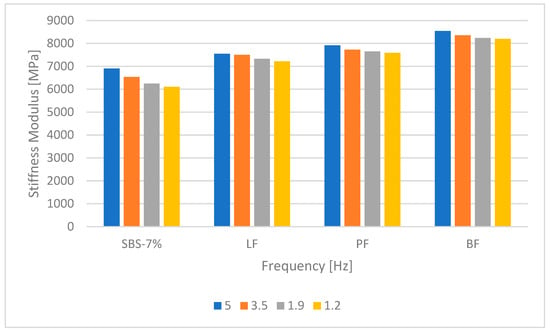
Figure 1.
Comparison of stiffness modulus values at different loading frequencies.
As observed, the increase in loading rate of up to 70 MPa/s further enhances the indirect tensile strength of each mixture type. A gradual increase in indirect tensile strength can be observed for base asphalt with 1.522 MPa at 10 MPa/s and a maximum strength of 3.483 MPa at 70 MPa/s. A similar pattern of increment in indirect tensile strength can be observed for modified mixtures. CR-20 exhibits the maximum accumulation of indirect tensile strength at 3.898 MPa at 70 MPa/s. SBS modified mixtures show higher increment in indirect tensile strength gain due to better cohesion of modified bitumen with aggregates, with SBS-7 leading to strength of 4.053 MPa at a loading rate of 70 MPa/s.
3.3. ITST Based on Loading Rate Variations
Since the variations in loading rates can affect the response of asphalt mixtures while being tested, the indirect tensile of asphalt mixtures was evaluated with loading rates of 10 MP/s to 70 MPa/s with increment of 10 MPa/s.
The visual representation of indirect tensile strength values for each scenario is shown in Figure 2. As observed, indirect ensile strength increases with the increase in loading rate from 10 MPa/s to 70 Mpa/s. The curve acts like a creep loading curve where gradual loading increases the plastic strain values. As observed, the lowest tensile strength values are shown by SBS-7% mixture, followed by LF modified asphalt mixtures. A 25% increase in tensile strength can be observed for the BF mixture when compared to SBS-7% mixture. LF and PF exhibit almost similar performance until the loading rate of 20 MPa/s; however, after the loading rate is increased to 20 MPa/s, indirect tensile strength for PF increases significantly, thereby widening the gap. Both BF and PF modified mixtures provide significant permanent deformation and cracking resistance at higher loading rates.
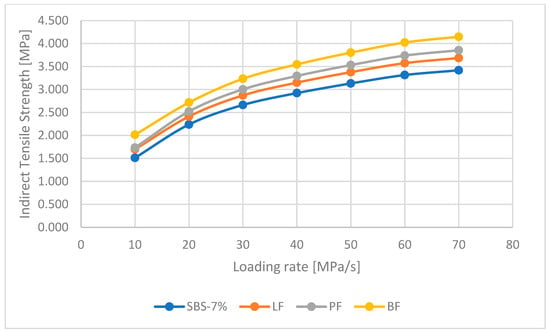
Figure 2.
Comparison of indirect tensile strength values at different loading rates.
3.4. DSR Testing
The complex modulus of different scenarios based on temperature variations is shown in Figure 3. As observed, the complex modulus decreases with an increase in temperature. The lowest magnitude of complex modulus is exhibited by the SBS-7% asphalt mixture. The addition of fibers further increases the complex modulus of the mixtures, with BF exhibiting the highest complex modulus. PF closely follows the complex modulus variations of BF, while LF exhibits the lowest complex modulus among the fiber-modified bitumen mixtures. The formation of a spatial network as a result of using fibers, effectively displaces the external loads, thereby creating a bituminous mixtures with higher resistance to permanent deformation.
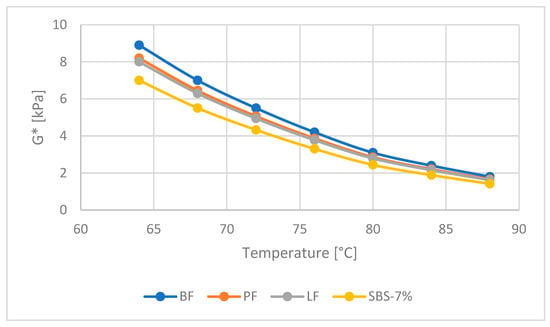
Figure 3.
Complex shear modulus for different scenarios.
The phase angle for bitumen mixtures at different temperature variations is shown in Figure 4. Since fibers are elastic, the addition of fibers to asphalt reduces the portion of viscous part in bitumen, further causing decrease in the phase angle. Therefore, the deformation resistance is further improved under high-temperature conditions. BF has the least sensitivity to phase angle variations with temperature changes and exhibits the least phase angle among other scenarios. PF closely follows the phase angle variation of BF with a slightly higher magnitude. LF shows the highest phase angle among the fiber-modified mixtures. The SBS-7% mixture exhibits the maximum phase angle, showing a larger viscous portion and leading to occurrence of extreme permanent deformation under high-temperature conditions. Both LF and BF perform better than the base scenario with only SBS-7% SBS, which extends the previous research conducted by Wu et al. [36] in terms of separate evaluation of the rutting parameter, phase angle and complex shear modulus.
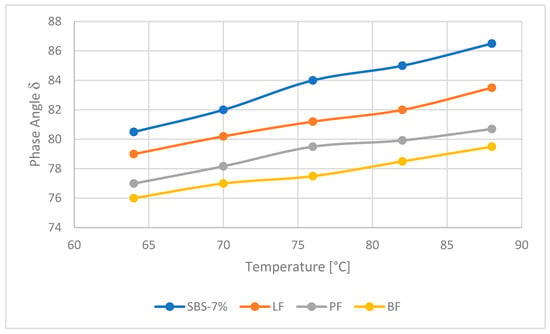
Figure 4.
Phase angle for different scenarios.
The rutting factors of different scenarios based on temperature variations are shown in Figure 5. Rutting factor provides the performance of bituminous mixtures against rutting and is a measure of rutting resistance. Rutting factor decreases with the increase in temperature, leading to higher occurrence of rutting for bituminous mixtures at high temperatures. The addition of fibers significantly increases the G*/Sinδ magnitudes, leading to higher resistance to permanent deformation. Basalt fiber exhibits the highest value of G*/Sinδ compared to polyester and lignin fibers. Basalt and polyester fibers offer the same performance improvement in some scenarios. However, in the case of lignin fiber, the difference in G*/Sinδ is significant due to inadequate absorption of asphalt binder and reduced density of lignin fibers when mixed. Furthermore, basalt fibers increase the viscosity of asphalt binder, leading to better overall high-temperature performance [1]. Fibers increase the rutting resistance in asphalt mixtures by enhancing the crosslinking of hydrocarbon chains in the bitumen. Among the fiber-modified bitumen samples, BF exhibits the highest rutting factor, closely followed by PF, while the least rutting factor is exhibited by LF. Natural fibers, in case of LF, cannot yield the same results as their inorganic counterparts due to weak resistance to moisture, less compatibility between fiber and matrix, insignificant stability and biodegradation [15].
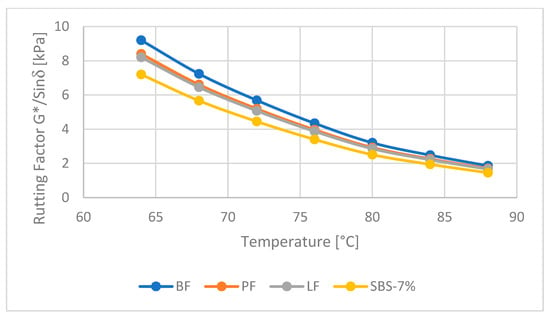
Figure 5.
Rutting factor for different scenarios.
4. Finite Element Modeling
4.1. Data for Modeling
The behavior of viscoelastic materials can be modeled by the Burger’s logit model for understanding the stress–strain response [22]. Furthermore, the data from dynamic modulus testing is used to evaluate the parameters for the Burger’s logit model, as shown in Equation (5). [37]. Burger’s model consists of Maxwell and Kelvin models, where it can reflect both elastic deformation and stress relaxation, thereby efficiently modeling the mechanical behavior of asphalt mixture [38]. The modified Burger’s logit model is used to incorporate the effect of decreasing viscous deformation with increasing time, thereby stabilizing the viscous deformation [37]. A generalized dashpot is used in case of modified Burger’s logit model, where the strain further decreases and stabilizes.
where is the creep strain of modified Burger’s model, is the dynamic modulus, is the internal damper parameter, n2, and are the model viscoelastic fitted parameters and is the damage value. Creep strain values are evaluated at temperature of 30 °C in order to reduce bias regarding rutting progression at high temperatures. This model utilizes the material decay function with the use of external damper and external spring for accurate evaluation of deformation in viscoelastic materials.
The Burger’s logit model parameters are shown in Table 8. As observed, a gradual increase in n2 values occurs for the BF mixture. SBS-7% yields the least n2 value of 6482.36 MPa, while the addition of fiber increases both A and n2 parameters for all mixture types, with the maximum value of A exhibited by BF at 167.89 MPa. The performance of both LF and PF modified mixtures stay close with A parameter values at 158.36 MPa and 161.25 MPa, respectively. LF yields the least magnitude of n2 parameter among the fiber-modified mixtures at 6986.45 MPa.

Table 8.
Modified Burger’s logit model parameters.
Loading simulations were conducted using a cumulative axle load of 100 kN at 50,000 passes with a traffic speed of 90 km/h. A dual axle wheel was considered for exerting the load on the developed finite element model. Further loading details are shown in Table 9.

Table 9.
Loading details.
4.2. 2D Model Details
A 2D finite element model was created with an asphalt layer thickness of 15 cm resting on a rigid foundation. Visco step function of loading was employed to accurately evaluate the permanent deformation of the structure under 50,000 loading passes using cumulative loading time. Microstrains obtained from simulation results for various mixture types were further used for evaluation of distress mechanisms, including rutting and fatigue cracking. Convergence study was performed to allow for accurate determination of element size with higher accuracy and decreased simulation time. Mesh details are shown in Figure 6.

Figure 6.
Mesh details.
Model type is CPE4R with reduced integration and hourglass control. The total number of elements is 6145, with element size at five for increased accuracy and reduced simulation time. Boundary conditions were developed, where movements along the normal vertical direction were allowed. However, the movements along horizontal and parallel directions are restricted, thereby mitigating bias when evaluating the deformation under loading along the wheel path locations. The boundary conditions are shown in Figure 7.

Figure 7.
Loading and boundary conditions details.
4.3. Modeling Results and Discussion
Simulations for each mixture type were performed for a total of 50,000 axle passes in ABAQUS. The simulation results, in terms of Von Mises stress values, were obtained for each mixture type. Furthermore, the use of Visco step loading allows for accurate deformation of the pavement layer under loading, with upheaval zones along the pavement edge, as shown in Figure 8. In terms of increased deformation under loading, the fiber-modified SBS mixtures exhibit less deformation compared to the SBS-7% mixture.
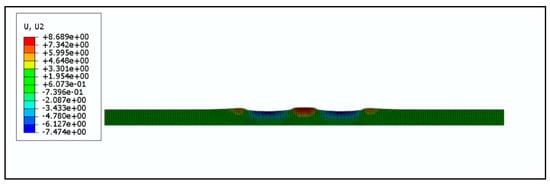
Figure 8.
Simulation results for SBS-7% mixture.
Von Mises tress values for each mixture type were obtained through different simulation runs. The values were recorded at depths of 50 mm, 450 mm and 800 mm. A gradual decrease in stress values can be observed with an increase in depth, as shown in Table 10. The highest stress concentration can be observed in the SBS-7%, where the absence of fibers results in less effective stress distribution, as reflected in the DSR results and high magnitudes of stress values compared to fiber-modified asphalt mixtures. The use of fibers significantly reduces stress concentration at critical depths.

Table 10.
Von Mises stress values for different scenarios.
5. Fatigue and Rutting Damage Analysis
Rutting damage in the pavement occurs as a result of increased shear deformation and densification of the pavement structure. As the number of loading passes increases, longitudinal cracks start to develop under the wheel paths. Further interlocking of the cracks develop lead to formation of alligator tracking until the pavement is no longer functional, resulting in fatigue damage. The Asphalt Institute model can be used to calculate the number of passes to fatigue damage using horizontal tensile strains at the bottom of the asphalt layer, as shown in Equation (6) [39].
where is the number of load repetitions to fatigue damage, is the horizontal tensile strain at the bottom of the asphalt layer and is the elastic modulus of asphalt mixture. The Asphalt Institute provides the relationship between compressive strain and number of passes to rutting damage, as shown in Equation (7).
where is the number of load repetitions to rutting damage and is the vertical compressive strain on top of subgrade. Horizontal tensile strains and vertical compressive strains for each mixture type are shown in Table 11. As observed, the highest magnitude of and exists for SBS-7% mixture at 39.4 and 562.4, respectively. With the addition of fiber to the mixtures, better cohesion and interlocking of bitumen and aggregates occur, and and values further decrease, with the least magnitude exhibited by BF mixture at 410.6 and 20.1, respectively. The strain values in terms of et ad ec decrease by 35% and 31%, respectively compared to BF mixture. Both LF and PF mixtures have closer and values, with a difference of 8% in values. BF mixture outperforms both LF and PF mixtures by 15% and 8% in terms of reduced et values. The number of passes to fatigue and rutting damage also increases in case of fiber-modified asphalt mixtures.

Table 11.
Microstrains and number of passes to fatigue and rutting damage.
The comparison of the number of passes to fatigue damage for each mixture type is shown in Figure 9. As observed, there is a significant reduction in deceased number of passes for SBS-7% mixture, with only 1.18 × 1010 passes. A slight improvement in increased number of passes can be observed for LF, with 1.98 × 1010 passes. BF shows better overall performance in terms of increased number of passes to fatigue damage, with the magnitude of passes at 4.63 × 1010. Better cohesion and elastic response with the use of BF in asphalt mixture further increases the rutting resistance.
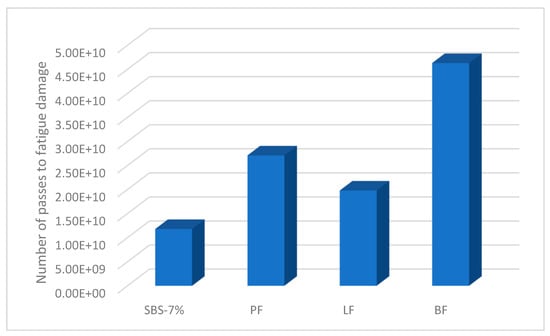
Figure 9.
Comparison of number of passes to fatigue damage.
The comparison of number passes to rutting damage is shown in Figure 10. All asphalt mixture types exhibit better performance against fatigue when compared to permanent deformation due to the presence of SBS modifier. However, the performance can be further improved with the use of fibers. As observed, the highest number of passes to rutting damage is exhibited by BF at 6.57 × 106 passes. PF follows the performance of BF modified SBS mixtures with a magnitude of 5.63 × 106 passes. The SBS-7% mixture, however, exhibits the lowest performance with only 1.52 × 106 passes to reach the rutting damage.

Figure 10.
Comparison of number of passes to rutting damage.
Rut depth at 1.6 million passes for each mixture type was calculated and shown in Figure 11. As observed, the maximum magnitude of rut depth is shown by for SBS-7% only mixture at 5.9 mm. The lowest magnitude of rut depth is shown by BF mixture at 3.5 mm. PF closely follows the rut depth of BF at 4.1 mm. LF also exhibits a closer rut depth magnitude to that of PF at 4.6 mm.
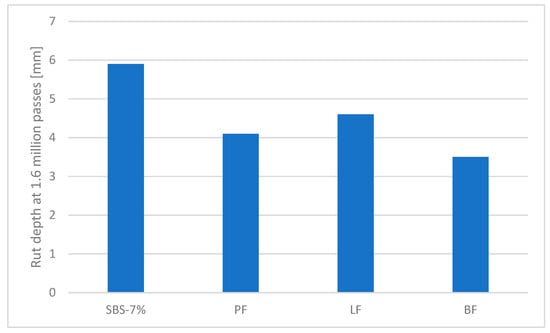
Figure 11.
Rut depth at 1.6 million passes for different scenarios.
6. Conclusions and Findings
In this research, the performance of three different fiber types—LF, PF and BF—was compared with the SBS-7% mixture in terms of indirect tensile strength, stiffness modulus and DSR values. Furthermore, indirect tensile strength tests were conducted at various loading rates, ranging from 10 MPa/s to 70 MPa/s. Stiffness modulus values were calculated across various frequency ranges: 5 Hz, 3.5 Hz, 1.9 Hz and 1.2 Hz. Moreover, finite element modeling was performed using the modified Burger’s logit model to simulate material decay in terms of rutting and fatigue damage.
When comparison is performed among all fiber types, BF modified mixtures exhibit the highest stiffness modulus, outperforming PF and LF by 7% and 12%, respectively. In terms of mixture strength without fiber reinforcement, SBS-7% provides the least indirect tensile strength when compared to fiber-modified mixtures, with a 16% reduction in strength compared to LF modified mixtures. Therefore, further improvement in stiffness modulus under higher-temperature conditions can be observed when the fibers are used. As observed from the experimental results, the reduction in stiffness modulus for SBS-7% is 35% when compared to BF modified mixtures, with a higher phase angle and lower resistance to permanent deformation for the SBS-7% mixture. Furthermore, the use of fibers further enhances the cohesion and interlocking between bitumen and aggregates, leading to higher deformation resistance of asphalt mixtures. The presence of fibers further enhances the interlocking between binder and aggregates, leading to increased permanent deformation resistance. Fiber-modified asphalt mixtures reduce fatigue damage by an average of 25%. Furthermore, BF modified asphalt mixtures outperform LF mixtures by 12% in terms of the number of passes to fatigue damage.
BF modified asphalt mixtures exhibit a high complex shear modulus, followed by PF modified asphalt mixtures. Performance gains in terms of indirect tensile strength and complex shear modulus can be observed for fiber-reinforced mixtures compared to the SBS-7%-only mixture. Therefore, the use of fibers in high-volume applications for large-scale road construction projects makes them an excellent candidate for improving both high- and low-temperature performance of asphalt mixtures. The findings are as follows.
- 1.
- A higher magnitude of rutting parameter g*/sin exists for fiber-modified asphalt mixtures, resulting in higher rutting resistance when compared to the SBS-7% only asphalt mixture.
- 2.
- BF modified asphalt mixture exhibits the least sensitivity to phase angle variations among the fiber-modified asphalt mixtures (PF and LF), thereby providing high permanent deformation resistance.
- 3.
- The number of passes to rutting damage increases by 28% when the performance of BF is compared with that of SBS-7%.
Author Contributions
Conceptualization, M.F. and R.N.; methodology, M.F. and R.N.; software, M.F.; validation, M.F.; formal analysis, M.F.; investigation, M.F.; resources, M.F.; data curation, M.F.; writing—original draft preparation, M.F.; writing—review and editing, R.N.; visualization, M.F.; supervision, M.F.; project administration, M.F. All authors have read and agreed to the published version of the manuscript.
Funding
This research received no external funding.
Institutional Review Board Statement
Not applicable.
Informed Consent Statement
Not applicable.
Data Availability Statement
The data presented in this study are available in this current article.
Conflicts of Interest
The authors declare no conflicts of interest.
References
- Zhu, Y.; Li, Y.; Si, C.; Shi, X.; Qiao, Y.; Li, H. Laboratory Evaluation on Performance of Fiber-Modified Asphalt Mixtures Containing High Percentage of RAP. Adv. Civ. Eng. 2020, 2020, 5713869. [Google Scholar] [CrossRef]
- Lee, S.J.; Rust, J.P.; Hamouda, H.; Kim, Y.R.; Borden, R.H. Fatigue Cracking Resistance of Fiber-Reinforced Asphalt Concrete. Text. Res. J. 2005, 75, 123–128. [Google Scholar] [CrossRef]
- Wu, S.; Ye, Q.; Li, N. Investigation of Rheological and Fatigue Properties of Asphalt Mixtures Containing Polyester Fibers. Constr. Build. Mater. 2008, 22, 2111–2115. [Google Scholar] [CrossRef]
- Pirmohammad, S.; Majd Shokorlou, Y.; Amani, B. Laboratory Investigations on Fracture Toughness of Asphalt Concretes Reinforced with Carbon and Kenaf Fibers. Eng. Fract. Mech. 2020, 226, 106875. [Google Scholar] [CrossRef]
- Guo, Q.; Li, L.; Cheng, Y.; Jiao, Y.; Xu, C. Laboratory Evaluation on Performance of Diatomite and Glass Fiber Compound Modified Asphalt Mixture. Mater. Des. 2015, 66, 51–59. [Google Scholar] [CrossRef]
- Zhang, X.; Lou, C.; Lyu, X. Experimental Study on Direct Tensile Fatigue Performance of Basalt Fiber Reinforced Concrete. Sci. Rep. 2024, 14, 765. [Google Scholar] [CrossRef]
- Cui, K.; Xu, L.; Li, X.; Hu, X.; Huang, L.; Deng, F.; Chi, Y. Fatigue Life Analysis of Polypropylene Fiber Reinforced Concrete under Axial Constant-Amplitude Cyclic Compression. J. Clean. Prod. 2021, 319, 128610. [Google Scholar] [CrossRef]
- Liang, R.; Yu, W.; Luo, Z. Laboratory Investigation on Pavement Performance of Basalt Fiber-Reinforced Asphalt Mixture Under the Coupling Effect of Freeze-Thaw Cycles and Aging. Front. Mater. 2022, 9, 930056. [Google Scholar] [CrossRef]
- Wang, Y.; Ren, Q.; Xu, J. Influence of Basalt Fiber on the Mechanical Properties and Deformation Failure of Concrete after High Temperature. Adv. Civ. Eng. 2024, 2024, 6846792. [Google Scholar] [CrossRef]
- Wu, J.; Hong, R.; Gu, C. Influence of Fiber Type on Low-Temperature Fracture Performance of Presawed Asphalt Mixture Beams. Adv. Mater. Sci. Eng. 2018, 2018, 5087395. [Google Scholar] [CrossRef]
- Kadla, J.F.; Kubo, S.; Venditti, R.A.; Gilbert, R.D.; Compere, A.L.; Griffith, W. Lignin-Based Carbon Fibers for Composite Fiber Applications. Carbon 2002, 40, 2913–2920. [Google Scholar] [CrossRef]
- Cooley, J.; Brown, E.R.; Watson, D.E. Evaluation of Open-Graded Friction Course Mixtures Containing Cellulose Fibers. Transp. Res. Rec. 2000, 1723, 19–25. [Google Scholar] [CrossRef]
- Shanbara, H.K.; Ruddock, F.; Atherton, W. A Laboratory Study of High-Performance Cold Mix Asphalt Mixtures Reinforced with Natural and Synthetic Fibres. Constr. Build. Mater. 2018, 172, 166–175. [Google Scholar] [CrossRef]
- Zhang, J.; Huang, W.; Zhang, Y.; Lv, Q.; Yan, C. Evaluating Four Typical Fibers Used for OGFC Mixture Modification Regarding Drainage, Raveling, Rutting and Fatigue Resistance. Constr. Build. Mater. 2020, 253, 119131. [Google Scholar] [CrossRef]
- Jia, H.; Sheng, Y.; Guo, P.; Underwood, S.; Chen, H.; Kim, Y.R.; Li, Y.; Ma, Q. Effect of Synthetic Fibers on the Mechanical Performance of Asphalt Mixture: A Review. J. Traffic Transp. Eng. (English Ed.) 2023, 10, 331–348. [Google Scholar] [CrossRef]
- Li, B.; Liu, M.; Kang, A.; Zhang, Y.; Zheng, Z. Effect of Basalt Fiber Diameter on the Properties of Asphalt Mastic and Asphalt Mixture. Materials 2023, 16, 6711. [Google Scholar] [CrossRef]
- Zhang, X.; Chen, H.; Barbieri, D.M.; Hoff, I. Laboratory Evaluation of Mechanical Properties of Asphalt Mixtures Exposed to Sodium Chloride. Transp. Res. Rec. 2022, 2676, 90–98. [Google Scholar] [CrossRef]
- Slebi-Acevedo, C.J.; Lastra-González, P.; Castro-Fresno, D.; Bueno, M. An Experimental Laboratory Study of Fiber-Reinforced Asphalt Mortars with Polyolefin-Aramid and Polyacrylonitrile Fibers. Constr. Build. Mater. 2020, 248, 118622. [Google Scholar] [CrossRef]
- Xu, Q.; Chen, H.; Prozzi, J.A. Performance of Fiber Reinforced Asphalt Concrete under Environmental Temperature and Water Effects. Constr. Build. Mater. 2010, 24, 2003–2010. [Google Scholar] [CrossRef]
- Yang, S.; Zhou, Z.; Li, K. Influence of Fiber Type and Dosage on Tensile Property of Asphalt Mixture Using Direct Tensile Test. Materials 2023, 16, 822. [Google Scholar] [CrossRef]
- Pang, Y.; Li, H.; Han, Z.; Wu, P.; Lin, H. Performance Evaluation of Asphalt Mixture Reinforced by Lignin and Ceramic Fiber. J. Eng. Res. 2024. [Google Scholar] [CrossRef]
- Luo, D.; Khater, A.; Yue, Y.; Abdelsalam, M.; Zhang, Z.; Li, Y.; Li, J.; Iseley, D.T. The Performance of Asphalt Mixtures Modified with Lignin Fiber and Glass Fiber: A Review. Constr. Build. Mater. 2019, 209, 377–387. [Google Scholar] [CrossRef]
- Zhu, C.; Luo, H.; Tian, W.; Teng, B.; Qian, Y.; Ai, H.; Xiao, B. Investigation on Fatigue Performance of Diatomite/Basalt Fiber Composite Modified Asphalt Mixture. Polymers 2022, 14, 414. [Google Scholar] [CrossRef] [PubMed]
- Jiu, X.; Wang, Y.; Wu, Z.; Xiao, P.; Kang, A. High-Temperature Performance Evaluation of Asphalt Mixtures by Adding Short-Chopped Basalt Fiber. Buildings 2023, 13, 370. [Google Scholar] [CrossRef]
- Guo, Q.; Chen, Z.; Liu, P.; Li, Y.; Hu, J.; Gao, Y.; Li, X. Influence of Basalt Fiber on Mode I and II Fracture Properties of Asphalt Mixture at Medium and Low Temperatures. Theor. Appl. Fract. Mech. 2021, 112, 102884. [Google Scholar] [CrossRef]
- Pei, Z.; Lou, K.; Kong, H.; Wu, B.; Wu, X.; Xiao, P.; Qi, Y. Effects of Fiber Diameter on Crack Resistance of Asphalt Mixtures Reinforced by Basalt Fibers Based on Digital Image Correlation Technology. Materials 2021, 14, 7426. [Google Scholar] [CrossRef]
- ASTM D5; Standard Test Method for Penetration of Bituminous Materials. ASTM International: West Conshohocken, PA, USA, 2017.
- ASTM D36; Standard Test Method for Softening Point of Bitumen (Ring-and-Ball Apparatus). ASTM International: West Conshohocken, PA, USA, 2010.
- ASTM D113; Standard Test Method for Ductility of Asphalt Materials. ASTM International: West Conshohocken, PA, USA, 2023.
- ASTM D2872; Standard Test Method for Effect of Heat and Air on a Moving Film of Asphalt Binder (Rolling Thin-Film Oven Test). ASTM International: West Conshohocken, PA, USA, 2022.
- ASTM D6084; Standard Test Method for Elastic Recovery of Bituminous Materials by Ductilometer. ASTM International: West Conshohocken, PA, USA, 2010.
- ASTM D4402; Standard Test Method for Viscosity Determination of Asphalt at Elevated Temperatures Using a Rotational Viscometer. ASTM International: West Conshohocken, PA, USA, 2012.
- Masoud, K. DSR-Based Test Procedures and Specification Guidelines for Grading PG 58-XX and PG 64S-XX Asphalt Binders in Kansas; Kansas Department of Transportation Bureau of Research: Topeka, KS, USA, 2020.
- ASTM D7175-15; Standard Test Method for Determining the Rheological Properties of Asphalt Binder Using a Dynamic Shear Rheometer. ASTM International: West Conshohocken, PA, USA, 2024.
- ASTM D6931-17; Standard Test Method for Indirect Tensile (IDT) Strength of Asphalt Mixtures. ASTM International: West Conshohocken, PA, USA, 2025.
- Wu, B.; Pei, Z.; Luo, C.; Xia, J.; Chen, C.; Kang, A. Effect of Different Basalt Fibers on the Rheological Behavior of Asphalt Mastic. Constr. Build. Mater. 2022, 318, 125718. [Google Scholar] [CrossRef]
- Ma, Y.; Wang, H.; Zhao, K.; Yan, L.; Yang, D. Study of a Modified Time Hardening Model for the Creep Consolidation Effect of Asphalt Mixtures. Materials 2022, 15, 2710. [Google Scholar] [CrossRef]
- Yang, J.; Xie, J.; Tang, X.; Zhang, H. Study on the Permanent Deformation of Asphalt Mixtures Based on the Modified Burgers Model. Front. Built Environ. 2024, 10, 1357396. [Google Scholar] [CrossRef]
- Zhou, F.; Fernando, E. A Review of Performance Models and Test Procedures with Recommendations for Use in the Texas M-E Design Program; Report Date Project 0-5798 13; Type of Report and Period Covered Unclassified; Texas Transportation Institute: College Station, TX, USA, 2007; Volume 7. [Google Scholar]
Disclaimer/Publisher’s Note: The statements, opinions and data contained in all publications are solely those of the individual author(s) and contributor(s) and not of MDPI and/or the editor(s). MDPI and/or the editor(s) disclaim responsibility for any injury to people or property resulting from any ideas, methods, instructions or products referred to in the content. |
© 2025 by the authors. Licensee MDPI, Basel, Switzerland. This article is an open access article distributed under the terms and conditions of the Creative Commons Attribution (CC BY) license (https://creativecommons.org/licenses/by/4.0/).